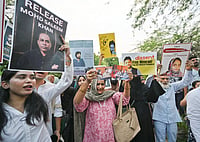Fairytale Beginnings
- Diana turns a princess in 1981; Kate 30 years later
- Both events capture popular imagination, speaking of an enduring ‘princess’ fantasy
- Regressive, say feminists; but it’s really a power metaphor
***
The image looked so familiar—there was the well-dressed young British woman, crouching down with a radiant smile, next to a bashful young girl blushing furiously and delightedly. But this time it was Kate Middleton, Britain’s new princess, who has assumed the mantle left by Prince William’s mother, Lady Diana Spencer. Like her much-mourned mother-in-law’s nuptials, Kate Middleton’s wedding was fetishised, scrutinised and watched by millions around the globe, her ascension to princess status sprinkled with the stardust of glowing press. But isn’t there something weirdly retro about the obsession with Kate Middleton as our new princess figure? Do we even need a ‘princess’ job category when news events are grim, no one believes in fairytale endings and women no longer wait around to see if the glass slipper fits?
I would argue that the fascination with princesses is never, on one level, going to go away—but that the princess icon is changing. Any mother of a girl child knows that at about three and four that girl is likely to intensely identify with princesses. She wants the tiara, the sparkly sceptre, the glittery shoes and the flouncy chiffon-skirted costume; she relates to the Disney princesses who swell the pantheon anew with each generation: Cinderella, whose tiny foot destines her for the throne; Anastasia, the secret princess whose regality was unknown even to herself; Belle, who is discovered by a prince trapped in the body of a Beast and elevated to princesshood. Hollywood updates the tale regularly: the first film made from the popular series The Princess Diaries takes ingenue Anne Hathaway from a grungy high school student with bad eyebrows to princess lessons to prepare for leading the mythical nation of Genovia.
The second wave of feminism deconstructed the Sleeping Beauty narrative and other princess myths as a form of hypnotism, designed to seduce women into marriage and passivity, and structured to teach them that their real lives only began with the kiss of a prince. Even today, I meet right-on feminist moms horrified at the enduring appeal of this story to their egalitarian-raised kindergartners: why, they ask me, is my daughter obsessed with being a princess?
I would tell them not to worry: second-wave feminists have it wrong. If you look closely, the princess archetype is not about passivity and decorativeness: it is about power and the recognition of the true self. Little girls are obsessed with princesses for the same reason little boys are obsessed with action heroes, whom they identify by their ‘powers’. What other female role model can issue a sentence and have the world at her feet? What other female figure can command an army, break open a treasury, or even, as in images of Kate Middleton or of Diana Spencer, simply bestow, with her presence, a sense of magic, excitement and healing? Princesses are more benevolent than pop stars and less drugged out; they are more powerful than Hillary Clinton or Condoleezza Rice, and wear better frocks. They are less disposable than fashion models and at least appear to be less stressed than the girls’ own working mothers, even if those women are at the top of the professional hierarchy. What girl would not be drawn to such an archetype, given how few other female role models you can say that about in our popular culture?

Kate Middleton has got middleclassness to royalty. (Photograph by Andrew Testa)
Into that script walked two important recent princesses, who each in her own way was a pioneer of the job. Princess Diana has been analysed for decades but few give her credit for being a genuine subversive in relation to Britain’s class system. Because she was so conventionally beautiful and not conventionally well-educated, her deployment of her message is read as accidental or instinctive—but I believe she thought carefully and analytically. In a time when Britain had even more rigid class stratification than it does today, she embraced families on housing estates and kids who lacked employment; when it cordoned off ‘high culture’ for the monarchy and elites, she supported the concerts of Elton John and Wham! At a time when AIDS patients were shunned, she had her photo taken embracing them. When Muslim British citizens were seen as “not truly British”, she, as a single woman, provocatively dated the most handsome and wealthy of them.
I believe Diana knew that Britain and its elites had to change if the country was to enter an authentic relationship with the world and history, and she took on in her own persona, in a Wildean way, the tasks of driving and of embodying that change. She waged a kind of conscious, semiotic war on the static status quo. To her credit, she understood—as her Queenly, equally conscious predecessors Elizabeth I and Victoria did—the power she had. Elizabeth I used her gowns and jewels, her whitened complexion and her shaved forehead, her retinue and what we would call her star power to send important political messages about Britain’s colonial role, about her own unchallengeable, allegorised status as a ‘virgin’ queen and about the legitimacy of her reign. Victoria used her ‘brand’ as the nation’s most archetypal mother figure, devoted wife, arbiter of respectability and blesser of the public good to send messages about Britain’s social stability during a period of great crises around reform; to legitimise and calm the shocks of industrial upheavals; and to distinguish her monarchy, with its bourgeois domestic values, from that of the royal rakes and adulterers before her. Diana carried on the tradition of British female royalty using the trappings of beauty, clothing or more domestic personas stealthily to attain substantial political ends.
Now enter Kate Middleton: why the frenzy? In a sense, Ms Middleton (Mrs Windsor) takes, as everyone subliminally recognises, her mother-in-law’s rather radical mission, legitimises it and brings it a generation into the future—in a Britain that has largely changed in the ways that Diana wished and intended it to. Kate is princess of a far more inclusive, multi-ethnic and socially flattened UK landscape. The Middletons’ own middle-class, aspirational family background—her great-grandfather was a coal miner—reveals a more socially mobile Britain than Diana knew. Kate’s outreach to people of all backgrounds, in her royal role, looks superficially like Diana’s—but it is free of that whiff of condescension that even Diana at her more egalitarian could not quite shake. Much is made of how Kate Windsor and her sister Pippa Middleton mix High Street, or main street, fashions with high-end pieces, and this focus is more than an assessment of their style; it reiterates that there is a middle-class-to-upper-class mix going on culturally, and perhaps even genetically, in Buckingham Palace. Will she do more dashing and notable things than slide a reassuring freshness, social openness and even ‘middleclassness’ into the royal context? It scarcely matters. In a way, it is more effective if she simply proceeds with what she has successfully managed this far: bringing the ‘common’ British citizen’s background of hard work, self-betterment and unpretentiousness inside the gates, without calling much attention to the subversiveness of that act.
Should we worry, as feminist mothers, when feisty, wilful daughters are obsessed with princesses? Hardly. The job description has changed. Princesses these days are not ladies who lunch. Indeed, where princesses these days go wrong—as Fergie so often does—is when they seem like Eurotrash who expect to be supported because of their connections, rather than getting down to it like the rest of us women. Princessing is good, hard work these days. Today’s princesses are visibly juggling a lot of balls, just like the rest of us working wives and single or married mothers. Perhaps reflexive disapproval of princesses is a bit passe.
At the same time, perhaps worldwide attention focused so much on the British princess because other princesses have not fared so well recently: Crown Princess Masako of Japan, a Harvard-Oxford-trained multi-linguist who worked as an international trade negotiator, has found the role of princess tough: she took eight years to produce an heir—actually, an heiress—rarely engages in public life, and is said to suffer from stress.
The king of Thailand’s oldest daughter gave up her royal title to marry an American commoner, but is now divorced and back in Thailand—so not the straight-ahead fairytale storyline. The current and third wife of her brother, who will inherit the Thai throne, is a naughty princess: a home video circulating on the internet depicts her celebrating the birthday of the prince’s poodle—topless. Not a Cinderella moment. And Saudi Arabia’s best-known princess narrative is a horror story: in 1977, by order of her grandfather, Misha’al bint Fahd al Saud was executed at 19 for alleged adultery. Given all these setbacks in the lives of real-life princesses, it is not surprising that the story that fits the archetype draws the spotlight.
This is true because more important than the ‘real’ role of a princess is the archetypal, even Jungian role that ‘the princess’ serves. After all, what are these Disney princesses doing? They are busy being the heroines of their own lives. In a scary face-off, Anastasia kills off the evil Rasputin—and saves Russia. Mulan, in drag, helps defeat the conquering Huns—also saving her family and her country. Belle releases her enslaved beloved from the curse of his enchantment. In The Princess Diaries, it is the Anne Hathaway character’s inner strength and grace that her regal grandmother develops, not just her posture and beauty. Even that slightly annoying Cinderella from the 1950 animated film is not so bad if we see that the glass slipper fits because she is nice to little creatures—and that it cannot fit her stepsisters not so much because they are ‘ugly’ as because they are unkind. Interesting that when fables are filled with actual narratives of female power, assertion and heroism, they are still read as being about beauty and passivity. Don’t worry if your five-year-old girl insists on a pink frilly princess dress. It doesn’t mean she wants to subside into froth; it just means, sensibly enough for her, that she wants to take over the world.
Naomi Wolf, A social critic and political activist, her next book Vagina: A Cultural History will be released in 2012

























